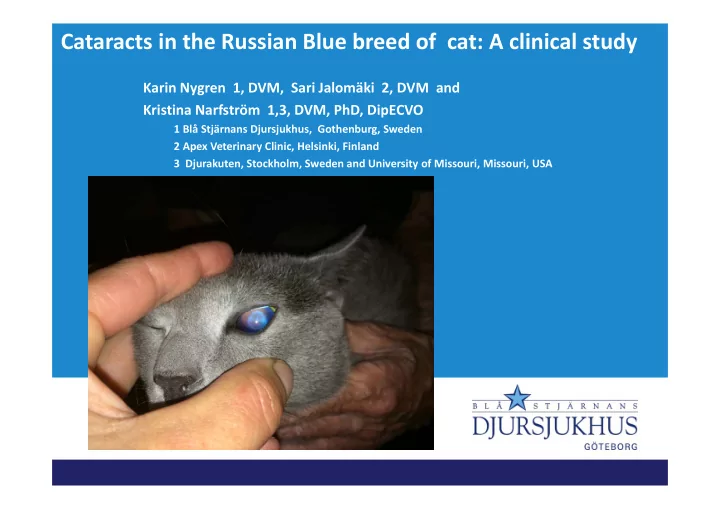

Cataracts in the Russian Blue breed of cat: A clinical study Karin Nygren 1, DVM, Sari Jalomäki 2, DVM and Kristina Narfström 1,3, DVM, PhD, DipECVO 1 Blå Stjärnans Djursjukhus, Gothenburg, Sweden 2 Apex Veterinary Clinic, Helsinki, Finland 3 Djurakuten, Stockholm, Sweden and University of Missouri, Missouri, USA
Introduction Dr Sari Jalomäki reported having observed cases of cataracts in the feline Russian Blue breed in Finland 2010 Small breed; about 3000 cats in Scandinavia The present study was initiated 2014 in collaboration with breed clubs mainly in Sweden, with the purpose to clinically describe the presumed inherited form of cataracts in the breed and to collect DNA samples for future molecular genetic studies
Materials and methods 66 cats studied (37 female, 29 male) Age between 3 month and 14 years All cats examined by Dr. Kristina Narfström during a 10 ‐ month period Evaluation of vision, PLR ’ s, dazzle ‐ and menace responces → dilata � on of the pupils with 0,5% tropicamide, → indirect ophthalmoscopy and slitlamp biomicroscopy Buccal swabs, using 4 ‐ 6 sterile cottonswabs for DNA extraction, were collected from 17 cats affected with cataracts and from 14 non ‐ affected cats > age 7 years
Results Most common form Less common, extended form Small triangular opacity at the Involvement of the entire nucleus border of the posterior nucleus and and parts of, or the entire anterior the anterior part of the posterior and posterior cortex cortex (arrow)
Age Normal Cataract ( Typical Extended Other Results gender) form form findings <4month 9 Out of 66 examined cats 6 ‐ 12month 2 2 (2M) 1 1 22 were affected with 1 year 1 2 (1F,1M) 2 cataracts ‐ 16 had the small, typical form 2 year 4 7 (3F, 4M) 5 2 1 ‐ 6 had extended forms 3 year 2 2 (2F) 2 1 4 year 4 1 (F) 1 1 Median age Mean age(year) 5 year 2 2 (2F) 2 ‐ Normal 4 4.2 ‐ Cataract 2.5 3.8 6 year 3 3 (1F,2M) 1 2 7 year 6 1(F) 1 Both genders equally 8 year 2 affected 9 year 1 1 Other ophthalmic findings 10 year 1 1(F) 1 ‐ 2 cases with retinopathy 11 year 1 1(F) 1 1 ‐ 1 anterior suture ‐ line cataract 14 year 1 ‐ 1 anterior cortikal cataract 39 22 (13F,9M) 16 6 5 ‐ 1 vitreus prolaps
Pedigree analyses Mating between two unaffected produce affected offspring in two different matings Mating between two affected produce affected offspring Both genders affected This supports an autosomal recessive mode of inheritance
Discussion Very few and old(1974 ‐ 1986) publications of cataracts in cats The localisation of the cataract in the perinuclear posterior cortex suggests a young age of initiation Only 3 cases have been followed for 1 ‐ 3 years with no notable progression Mode of progression needs to be further investigated. Relationship between the different forms is uncertain
Conclusions The Russian Blue cat breed is affected by a hereditary type of primary cataract Pedigree analyses indicates an autosomal recessive mode of inheritance The prevalance is high and appears to affect both genders equally The cataract appears to be early onset
Further studies Further studies are needed in order to clarify the exact time of onset, the mode of progression and if there is a relationship between the different forms of cataract in the breed Molecular studies are in progress e.g. GWAS; genome wide analysis study, to find the mutation The goal is to develop a genetic test for the mutation
Acknowledgements My coworkers: Dr. Sari Jalomäki and Dr. Kristina Narfström Russian Blue cats and their owners Ms. Kaija Merta Breeder’s clubs; Ryssfolket and Russian Blue klubben Financial support by ‐ Blå stjärnans djursjukhus, Göteborg ‐ Djurakuten, Stockholm ‐ Dr William J. Murphy, Texas A & M University, USA
Recommend
More recommend